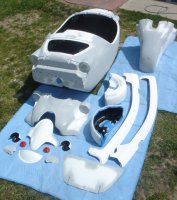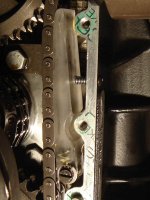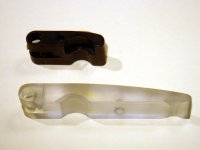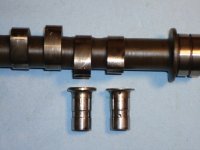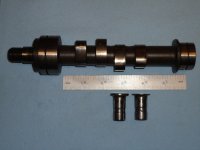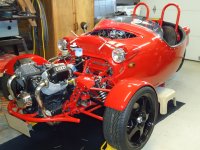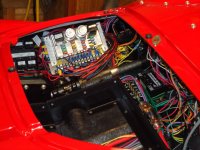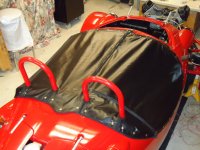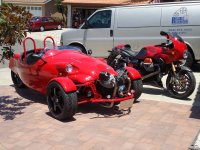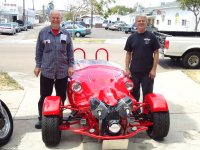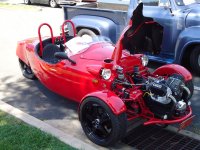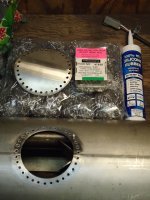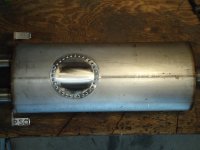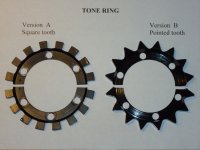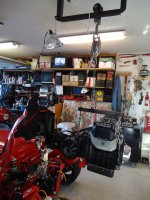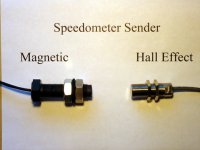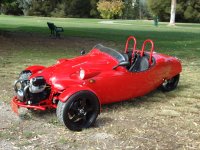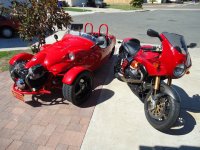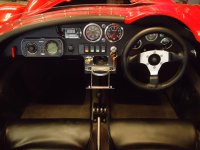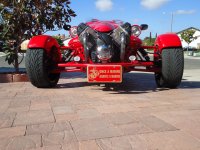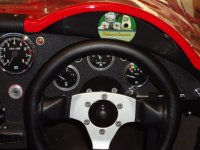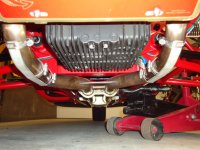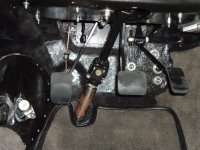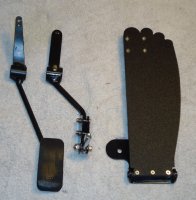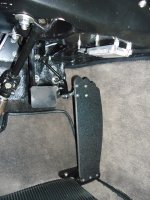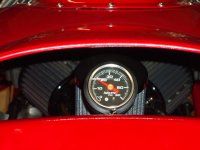Ganzo
Tuned and Synch'ed
- Joined
- Jul 17, 2009
- Messages
- 37
The Making of a Moto Guzzi Car
Part 13
At this point, nearly everything has been built. It was time to disassemble and prep for painting. Before that, I wanted to take it off the jack stands and roll it out for a few pictures. It was as exciting as taking out a freshly unwrapped sled on Christmas morning for its first run. Shoot, it might be as thrilling as receiving a Red Ryder 200-shot carbine action air rifle for Christmas. It didn’t matter that it didn’t run yet or that I was the only one excited. This was big stuff! It’s never been off the jacks. Once down on the ground on its own feet my initial thought was, “This really sits low”.
I went to get my wife so she could steer and brake while I pushed it into position. She sure looked good in the natural light. It didn’t matter that she was naked with no coat on. This was my baby and she was beautiful; that is, my wife. So after a few pictures of my wife, I went to get my son. He looked happier than my wife posing. The car fit him better and he looked natural in it, like, this is going to be mine some day.
I moved my V11 Rosso Corse into the picture and things were really looking good. I’m not a photographer, but I was enjoying what the camera caught. As the sun sets, so all good things must come to an end. Soon it was back on the jacks for disassembly. It was a little saddening so I dragged my feet a bit.
As I started taking it apart, I thought it might be interesting to count how many brackets I made. I counted 52. Almost all are stainless. I had them powder coated along with the dash. The empty boxes were now filling up again. Prepping for painting is about as much fun as getting poison ivy on a camping trip so I kept looking for other things to do.
All along, I’ve been thinking of the process of making it legal. More specifically, could it pass California EPA the first time through? The motor has to meet or exceed its design specifications. I had incorporated all the original design features except one. I didn’t have a charcoal canister (evaporative control system). I really didn’t want to clutter up a good design, but I don’t think EPA is dumb enough to over look it. So I retrieved the charcoal canister that I removed from my V11 when new and began searching for its new home. After some deliberation, I determined that the firewall under the voltage regulator was the best place for it. After another trip to the candy store I had all the connecting stuff that I needed. After plugging, drilling, routing, assembling and of course, more brackets, the surgery was done. It was the tidiest double bypass anyone has ever seen.
While working on the double bypass I also started on the front bumper. I personally feel that one should come with the kit or at least as an option. There really is no right or wrong, only preferences, when making the bumper. Because there isn’t a straight line anywhere on the car, I think that the bumper should have similar curves. I thought of many materials, but decided 1½˝ OD with ⅛˝ thick wall aluminum tubing would match best. This decision is primarily based on the 1½˝ OD of the exhaust pipes. To save a buck, my friend suggested I go to a used material yard in town since the place I normally buy from only had 12 ft. sticks of it. The closest aluminum tubing I could find in the yard was 1¼˝ OD with ⅛˝ thick wall. I figured that was close enough so I bought it along with some other aluminum that I thought might make some good brackets.
All along, bending the bumper was in my mind since I prefer to make it myself and save another dollar. I don’t like building tools for one time use so I called my friends until I found one who had a bender that I could borrow. He had several styles and sizes which made material selection easier for me. I ended up using a 1¼˝ EMT hand bender. It was a little tough, but with some help from my son we got it done. Since there are 4 bends in it, two of them reverse; the hardest part is making sure that all the bends are on a single plane. Getting the right amount of degrees is much easier and of course the radiuses are all the same as determined by bender.
California requires a front license plate which really complicates things for me, more on this later. I also plan on mounting fog lights on the bumper. Some other design considerations are protection, strength, absorbing impact and the motor vibrates while the frame is solid.
When figuring out how to mount the bumper I had to think 3 dimensionally. The frame is really far behind the bumper, but the unused front motor mount is close. If I mount the bumper to the frame, nothing substantial prevents the bumper from being deflected vertically. I can’t mount it rigidly to the motor because I don’t want the motor damaged in an impact. So the solution was to make a bracket that is designed to collapse upon impact yet provide enough rigidity to support the bumper vertically. Now, how best to attach it to the unused front motor mount? I don’t need a honking bolt to support the bracket which is welded to the bumper. So I made 2 brass sleeves that accommodate 8mm bolts and pressed them into the unused mount holes. The bracket is rubber mounted to the engine mount bolts to absorb engine vibration.
This sounds like a lot of work just for a bumper and it is. I usually don’t go into this much detail to keep you awake, but today I felt like this might interest a few of you. I next made the brackets to the frame. There are four of them, two on each side of the motor. The inner pair is made of 1˝ OD aluminum and is designed to withstand a substantial impact. The other pair further outboard is more ornamental. They are constructed of flat curved tempered aluminum. They attach to the ends of the bumper and could withstand a good impact and bounce right back. I stole this idea from old car bumpers. It’s practical, yet has beautiful curves that accent the car’s shape. Because of the crude bending tools that I used, these curves added a great deal of time to the project. Also, all of the joints are compound angles. If you can’t bend and splice to half a degree, then this project is not for you.
I made various caps and plugs for the bumper on the lathe then decided where to mount the fog lights. After a couple more brackets, I was ready to tackle the license plate mount. Before making the bumper I decided that the best location for the license plate was centered below the bumper. What really bothered me was its size, 6˝ by 12˝. It’s like a big barricade right in front of the oil pan. Not only is it not aerodynamic, it restricts cooling to the motor which would not be an issue if it was water cooled. I just couldn’t tolerate this air flow restriction so I made the license plate mount hinged and counter weighted. When stopped, it hangs vertical, but while in motion, the airflow pushes it horizontal. I’m betting that the police won’t mind. We’ll see. Anyway, it’s easy enough in the future to make it fixed, if need be. I decided to have the bumper powder coated the same color as the frame because it is clearly an extension of the prominently displayed supporting structure.
I’m running out of ideas, but was able to find a couple of projects that I had been thinking of in order to delay prepping the parts for painting. There are currently no lockable compartments in the car. It would be nice if the front storage compartment could be locked. I have about four spare elevator control panel locks under my work bench just waiting to be used. I’ll be darn, but these locks fit perfectly. I even have spare keys for them. I also made a battery hold down strap from old spare aircraft parts. Collecting old stuff has its value sometimes and sometimes it doesn’t. Kind of like the old motorcycle parts I’ve seen hanging from the rafters of some motorcycle shops. If no one knows theyexist they might as well be thrown away, but if they were on E-Bay, that’s another story.
Part 13
At this point, nearly everything has been built. It was time to disassemble and prep for painting. Before that, I wanted to take it off the jack stands and roll it out for a few pictures. It was as exciting as taking out a freshly unwrapped sled on Christmas morning for its first run. Shoot, it might be as thrilling as receiving a Red Ryder 200-shot carbine action air rifle for Christmas. It didn’t matter that it didn’t run yet or that I was the only one excited. This was big stuff! It’s never been off the jacks. Once down on the ground on its own feet my initial thought was, “This really sits low”.
I went to get my wife so she could steer and brake while I pushed it into position. She sure looked good in the natural light. It didn’t matter that she was naked with no coat on. This was my baby and she was beautiful; that is, my wife. So after a few pictures of my wife, I went to get my son. He looked happier than my wife posing. The car fit him better and he looked natural in it, like, this is going to be mine some day.
I moved my V11 Rosso Corse into the picture and things were really looking good. I’m not a photographer, but I was enjoying what the camera caught. As the sun sets, so all good things must come to an end. Soon it was back on the jacks for disassembly. It was a little saddening so I dragged my feet a bit.
As I started taking it apart, I thought it might be interesting to count how many brackets I made. I counted 52. Almost all are stainless. I had them powder coated along with the dash. The empty boxes were now filling up again. Prepping for painting is about as much fun as getting poison ivy on a camping trip so I kept looking for other things to do.
All along, I’ve been thinking of the process of making it legal. More specifically, could it pass California EPA the first time through? The motor has to meet or exceed its design specifications. I had incorporated all the original design features except one. I didn’t have a charcoal canister (evaporative control system). I really didn’t want to clutter up a good design, but I don’t think EPA is dumb enough to over look it. So I retrieved the charcoal canister that I removed from my V11 when new and began searching for its new home. After some deliberation, I determined that the firewall under the voltage regulator was the best place for it. After another trip to the candy store I had all the connecting stuff that I needed. After plugging, drilling, routing, assembling and of course, more brackets, the surgery was done. It was the tidiest double bypass anyone has ever seen.
While working on the double bypass I also started on the front bumper. I personally feel that one should come with the kit or at least as an option. There really is no right or wrong, only preferences, when making the bumper. Because there isn’t a straight line anywhere on the car, I think that the bumper should have similar curves. I thought of many materials, but decided 1½˝ OD with ⅛˝ thick wall aluminum tubing would match best. This decision is primarily based on the 1½˝ OD of the exhaust pipes. To save a buck, my friend suggested I go to a used material yard in town since the place I normally buy from only had 12 ft. sticks of it. The closest aluminum tubing I could find in the yard was 1¼˝ OD with ⅛˝ thick wall. I figured that was close enough so I bought it along with some other aluminum that I thought might make some good brackets.
All along, bending the bumper was in my mind since I prefer to make it myself and save another dollar. I don’t like building tools for one time use so I called my friends until I found one who had a bender that I could borrow. He had several styles and sizes which made material selection easier for me. I ended up using a 1¼˝ EMT hand bender. It was a little tough, but with some help from my son we got it done. Since there are 4 bends in it, two of them reverse; the hardest part is making sure that all the bends are on a single plane. Getting the right amount of degrees is much easier and of course the radiuses are all the same as determined by bender.
California requires a front license plate which really complicates things for me, more on this later. I also plan on mounting fog lights on the bumper. Some other design considerations are protection, strength, absorbing impact and the motor vibrates while the frame is solid.
When figuring out how to mount the bumper I had to think 3 dimensionally. The frame is really far behind the bumper, but the unused front motor mount is close. If I mount the bumper to the frame, nothing substantial prevents the bumper from being deflected vertically. I can’t mount it rigidly to the motor because I don’t want the motor damaged in an impact. So the solution was to make a bracket that is designed to collapse upon impact yet provide enough rigidity to support the bumper vertically. Now, how best to attach it to the unused front motor mount? I don’t need a honking bolt to support the bracket which is welded to the bumper. So I made 2 brass sleeves that accommodate 8mm bolts and pressed them into the unused mount holes. The bracket is rubber mounted to the engine mount bolts to absorb engine vibration.
This sounds like a lot of work just for a bumper and it is. I usually don’t go into this much detail to keep you awake, but today I felt like this might interest a few of you. I next made the brackets to the frame. There are four of them, two on each side of the motor. The inner pair is made of 1˝ OD aluminum and is designed to withstand a substantial impact. The other pair further outboard is more ornamental. They are constructed of flat curved tempered aluminum. They attach to the ends of the bumper and could withstand a good impact and bounce right back. I stole this idea from old car bumpers. It’s practical, yet has beautiful curves that accent the car’s shape. Because of the crude bending tools that I used, these curves added a great deal of time to the project. Also, all of the joints are compound angles. If you can’t bend and splice to half a degree, then this project is not for you.
I made various caps and plugs for the bumper on the lathe then decided where to mount the fog lights. After a couple more brackets, I was ready to tackle the license plate mount. Before making the bumper I decided that the best location for the license plate was centered below the bumper. What really bothered me was its size, 6˝ by 12˝. It’s like a big barricade right in front of the oil pan. Not only is it not aerodynamic, it restricts cooling to the motor which would not be an issue if it was water cooled. I just couldn’t tolerate this air flow restriction so I made the license plate mount hinged and counter weighted. When stopped, it hangs vertical, but while in motion, the airflow pushes it horizontal. I’m betting that the police won’t mind. We’ll see. Anyway, it’s easy enough in the future to make it fixed, if need be. I decided to have the bumper powder coated the same color as the frame because it is clearly an extension of the prominently displayed supporting structure.
I’m running out of ideas, but was able to find a couple of projects that I had been thinking of in order to delay prepping the parts for painting. There are currently no lockable compartments in the car. It would be nice if the front storage compartment could be locked. I have about four spare elevator control panel locks under my work bench just waiting to be used. I’ll be darn, but these locks fit perfectly. I even have spare keys for them. I also made a battery hold down strap from old spare aircraft parts. Collecting old stuff has its value sometimes and sometimes it doesn’t. Kind of like the old motorcycle parts I’ve seen hanging from the rafters of some motorcycle shops. If no one knows theyexist they might as well be thrown away, but if they were on E-Bay, that’s another story.

